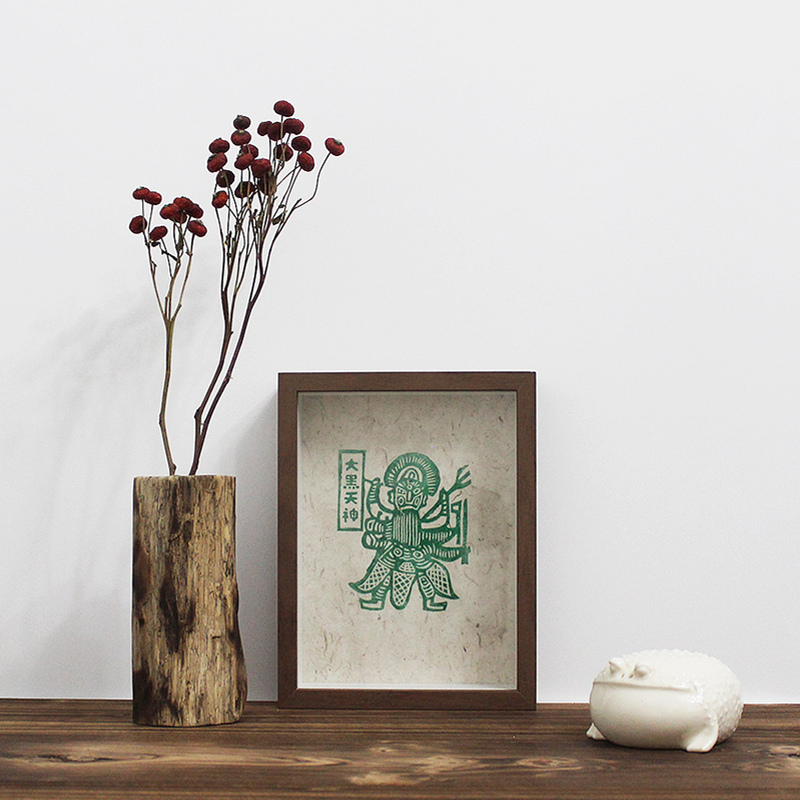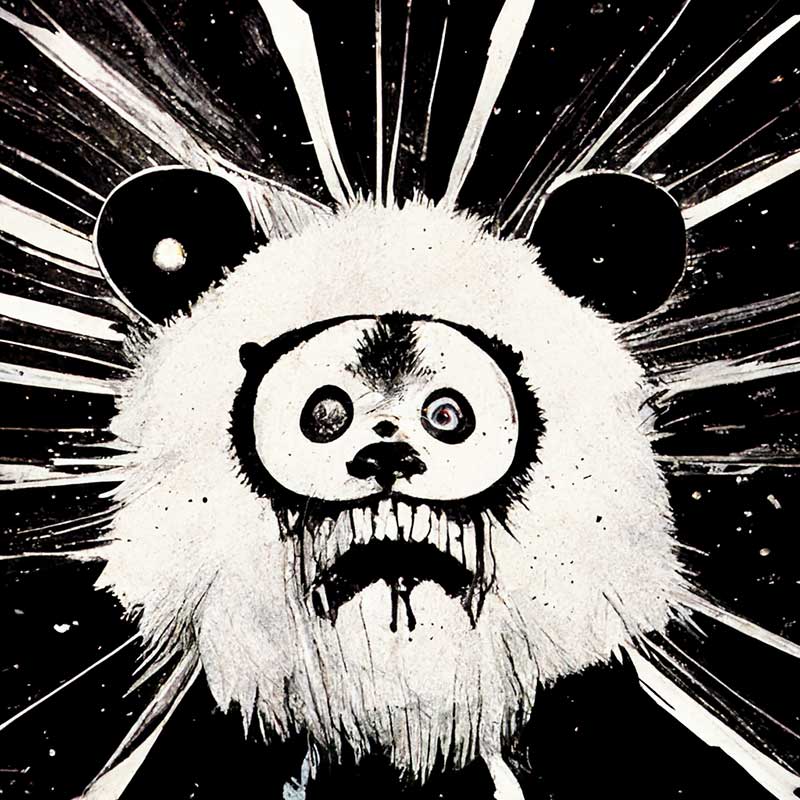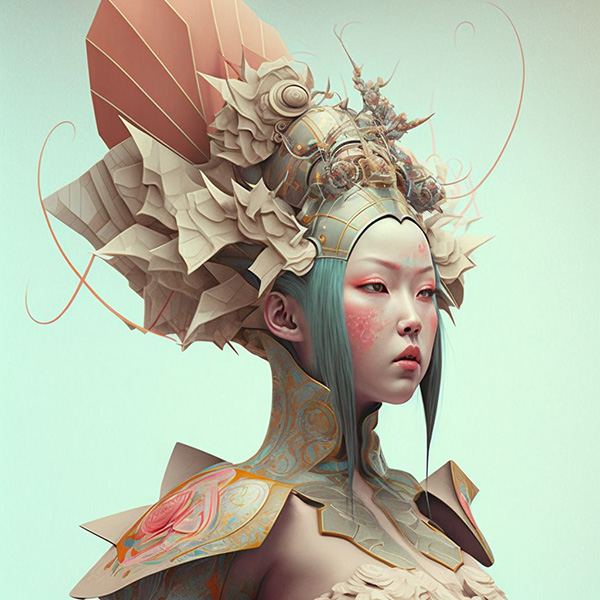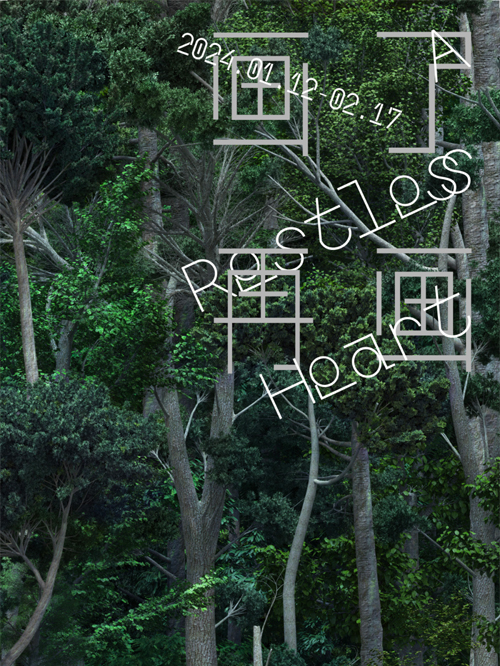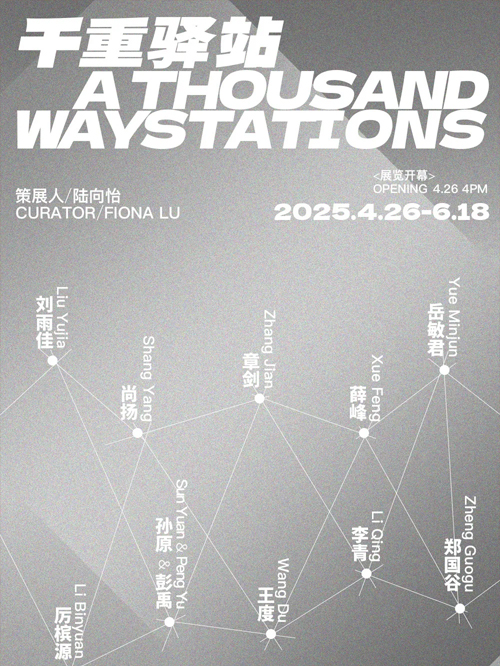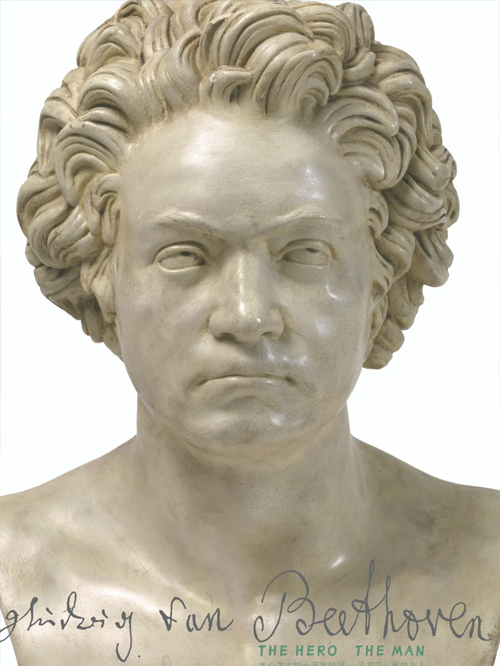当提及“画了再画”,脑海中首先浮现的是画家的画室。在那间四壁收藏满了未完成素描与彩色画作的房间里,空气中弥漫着油画特有的浓烈味道,夹杂着画家对于颜色和形状无尽的执着和探索。每一次的笔触,似乎都在试图超越前一刻的自己,画家对于“再画”的坚持,既是对技术的精进,也是对艺术极致的追求……
When it comes to "painting and painting again", the first thing that comes to mind is the painter's studio. In that room, the walls are full of unfinished sketches and colorful paintings, and the air is filled with the strong scent of oil paint, mixed with the painter's endless dedication and exploration of colors and shapes. Every stroke seems to be trying to surpass the previous moment, the painter's persistence of "re-painting" is not only the improvement of technology, but also the pursuit of the ultimate art…
在ChatGPT中输入指令“以‘画了再画’为题写一篇文章”,机器人会撰出以上这段短文,从想象画家的画室描述,到艺术家醉心于对技艺的打磨,再到心路历程的鸡汤,循序渐进,有理有据,感情颇丰。从技术层面来说,如果画家可以给算法提供足够的数据——即画作图库,让其学习,假以时日可以训练出一位AI画家代替其作画,随着数据库日益增长,AI将愈加接近画家本人的风格。但正如ChatGPT不知道该主题之下要写的是关于陈熹、柳迪、苏昱铭、王屿星、肖喆洛、赵亮六位艺术家的“画了再画”;AI只能让不掌握绘画技能,或无法熟练运用技能的人拥有自己的画作,算法做不到替画家选择他/她要什么样的作品,于何时开始,在哪里停下,更无从得知其作画的初衷,即“灵感”的来源。
If you input the command "Write an article with the title 'Painting and Painting Again'" in ChatGPT, the robot will generate the above passage. It starts with imagining the painter's studio, describes the artist's dedication to honing their craft, and then progresses to a heartfelt anecdote. From a technical perspective, if the painter can provide enough data to the algorithm - namely a library of their paintings for it to learn from, over time, it could be possible to train an AI painter to replicate their style. As the database grows, the AI will increasingly resemble the artist's style. However, just like ChatGPT didn't know that the topic was about six artists - Chen Xi, Liu Di, Su Yuming, Wang Yuxing, Xiao Zheluo, and Zhaoliang - who have "A restless heart"; AI can only allow those who don't possess painting skills or cannot proficiently use them to have their own paintings. The algorithm cannot replace the artist in choosing what kind of work they want, when to start or stop, nor can it access the original inspiration behind their painting.
“画了再画”展出的六位艺术家均生于上世纪80、90年代,于美院体系中完成训练, “从艺”经历平均近十年,也就是说若根据格拉德威尔的“一万小时定律”,人均两位“艺术家”[1]。但他们非但没有成为所谓的“成功艺术家”,甚至差点走向其他的人生职业轨迹。但从事其他工作,反而日益肯定了他们对创作的渴望。
The six artists exhibited in "A Restless Heart" were all born in the 1980s and 1990s and completed their training in the Academy of Fine Arts system. Their "artistic" experience averages nearly ten years, which means that according to Gladwell's "10,000-hour rule", they are all two "artists"[1]. But instead of becoming so-called "successful artists", they almost took other career paths in life. However, engaging in other work only confirmed their desire for creation.
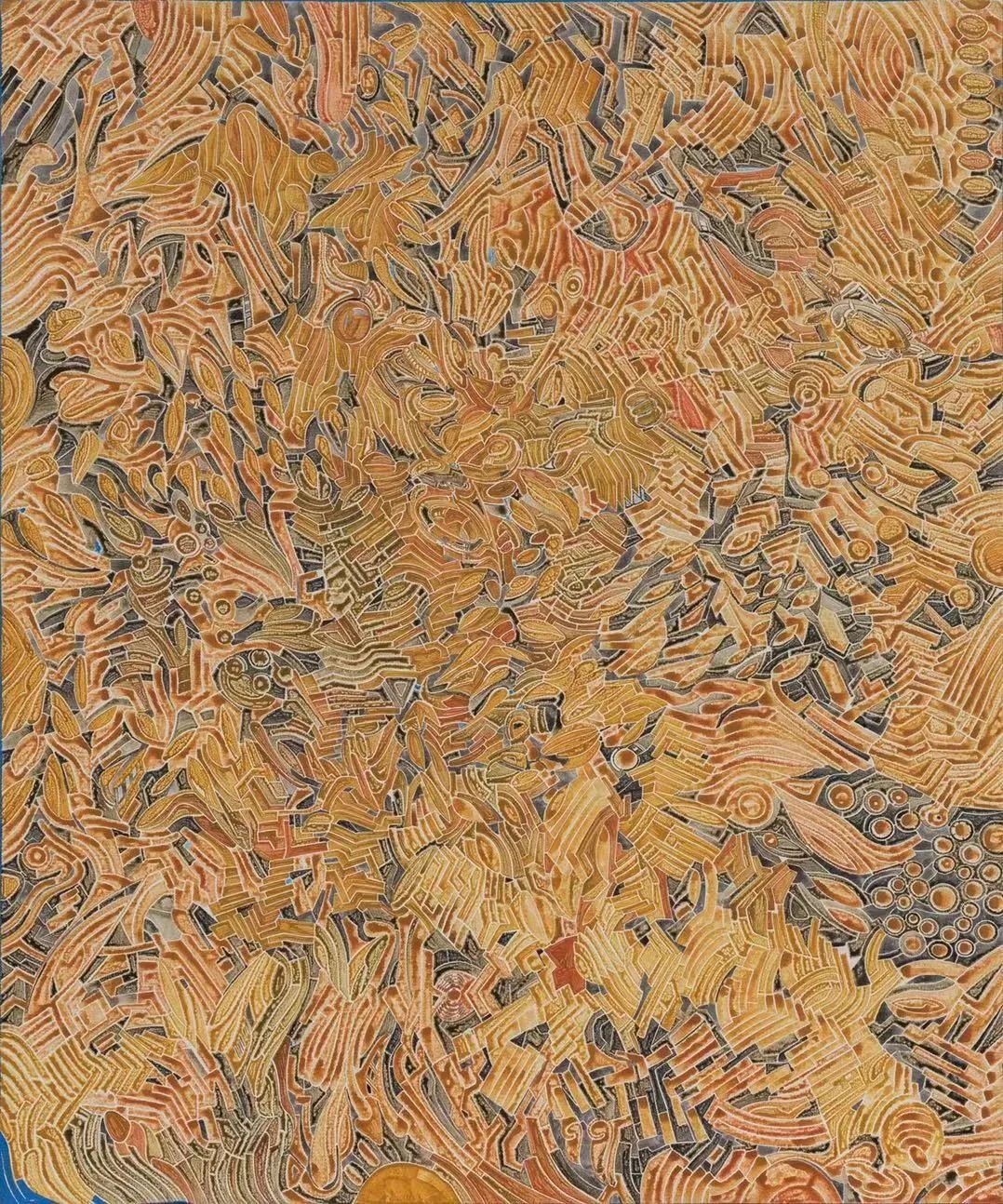
陈熹 Chen Xi
单层丙烯 No.35 Single Layer Acrylic No.35
布面丙烯 Acrylic on canvas
120 × 100cm 2016
陈熹(生于1985年)在2014-2017年间创作的绘画堆满了其居所的客厅,按系列整理,对自己的作品有系统的文字描述,他甚至可以撰写展评。但陈熹更为人所知的是其斩获国内外奖项的动画作品,这些影片由3D软件制作,导演、摄影、美术设计、特效,乃至声效设计,他担纲每一项职能,包括制作院线放映的DCP。此次展出的作品来自《单层丙烯》和《组成我那些由机器构成的平行世界里的抽象画细节》两个系列,在绚丽色彩和重复性图像的抽象画面中,埋藏着看似有形的符号,但并无具体指向的画面,终究还是single layer acylic(单层丙烯)。他亦将其画作放进其动画长片《步行指南》[2]中,使其成为片中美术馆级别的藏品。
Chen Xi (born in 1985) created paintings that filled the living room of his residence from 2014 to 2017. He sorted them into series, provided systematic written descriptions of his works, and even wrote exhibition reviews. However, Chen Xi is more well-known for his animation works that won awards at home and abroad. These films are made using 3D software, and he assumes every role, including directing, cinematography, art design, special effects, and even sound design. This time, the exhibited works come from two series: Single Layer Acrylic and Details of my abstract painting that from a parallel world composed of machines. In the abstract images with colorful colors and repetitive images, there are seemingly visible symbols without specific references to the picture, ultimately single acrylic. He also incorporates his paintings into his animated feature film Sleepwalking Through The Walk Simulators[2] to make them museum-level collections in the film.
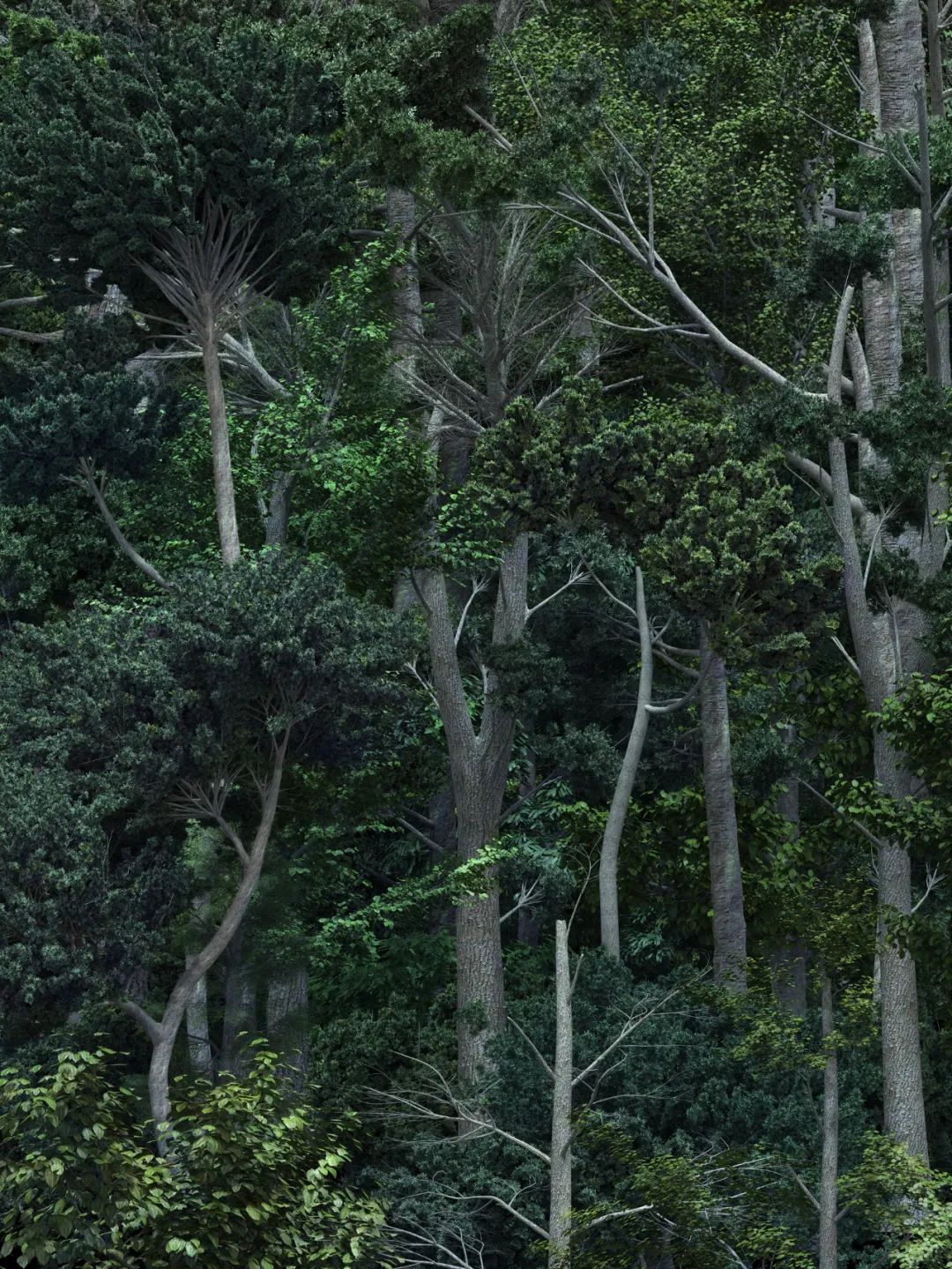
柳迪 Liu Di
自我的重量 No.5 The Weight of Oneself No.5
收藏级艺术微喷 Archival Inkjet Print
80×60cm 2017
柳迪(生于1985年)在2010年凭借《动物规则》系列获瑞士Lacoste爱丽舍摄影奖金奖,他的作品在视觉上充斥着突兀感和超现实的冲突,被刻意放大身躯缩小头部的动物孤独的沉坐于城市和废墟里。《自我的重量No.5》则放弃了该系列前作中具像的人物背影形象,只留下繁茂的丛林树木。从现实影像与CG建模结合,到全数字建模,柳迪的摄影作品变化反映出这15年里技术革新最真实的景象,摄影术的诞生将绘画从“画得像”的唯一标准中解放出来,走向当代;而AI的诞生和电影工业对后期特效技术的训练则将摄影艺术的边界拓展到更广阔的维度,摄影也可以不经由镜头生产,转而通过数位板绘制、数字仪器扫描或建模算法即可模拟现实,甚至从数据上来看比真实世界更接近“真实”。
Liu Di (born in 1985) won the Lacoste Elysee Prize in 2010 with his Animal Regulation series. His works are visually full of awkwardness and surreal conflicts, with animals deliberately enlarged and their heads deliberately reduced, sitting alone in the city and ruins. His The Weight of Oneself No.5 abandoned the previous image of the figure's back in this series, leaving only a lush jungle. From the combination of real images and CG modeling to full digital modeling, Liu Di's photographic works reflect the most authentic changes in technology in the past 15 years. The birth of photography has freed painting from the only standard of "drawing like," moving it towards modern times. The birth of AI and the film industry's training in post-production special effects have expanded the boundaries of photographic art to broader dimensions. Photography can now be simulated through digital drawing boards, digital instruments, scanning or modeling algorithms, without even producing through a camera lens. From a data point of view, it is even closer to "reality" than the real world.
然而脱离了按动快门和冲洗行为,摄影的传统不再被强调,摄影是否会经历绘画曾经面对的“已死”问题,正是王屿星(生于1985年)在其创作中所思考的。王屿星在美院学习期间的训练造就了其对图像和灵感之间关系的敏锐,《晕眩的下午》、《雪国》系列中,他将拍摄的图像进行校色、修瑕,并试图将“图像”同时当作画布和笔触来使用,用“灵感”来描述“灵感”本身[3],形成作品。他介入材料的行为很像在绘画,从内核来看,王屿星亦是很传统的图像作者,更尝试将摄影作品推向装置的方向,追寻形式的文艺复兴。
However, by removing the act of pressing the shutter and developing the image, the traditional photography is no longer emphasized. Whether photography will experience the "gone" that painting once faced is what Wang Yuxing (born in 1985) considers in his creative works. Wang Yuxing's training during his time at the Academy of Fine Arts cultivated his sensitivity to the relationship between images and inspiration. In his Dizzy Afternoon and Snow Country series, he calibrates and repairs the colors of the images he shoots, and tries to use "images" as both canvas and brushstroke, using "inspiration" to describe "inspiration"[3] itself to form his works. His intervention with materials is much like painting. In essence, Wang Yuxing is also a very traditional image creator, and he has also attempted to push photographic works towards installation art, pursuing a renaissance of forms.
而在绘画形式的溯古与创新这件事上,则可看向苏昱铭、肖喆洛和赵亮的架上绘画作品。
In terms of tracing back to ancient forms and innovating in painting, one can look at the easel paintings of Su Yuming, Xiao Zheluo and Zhao Liang.
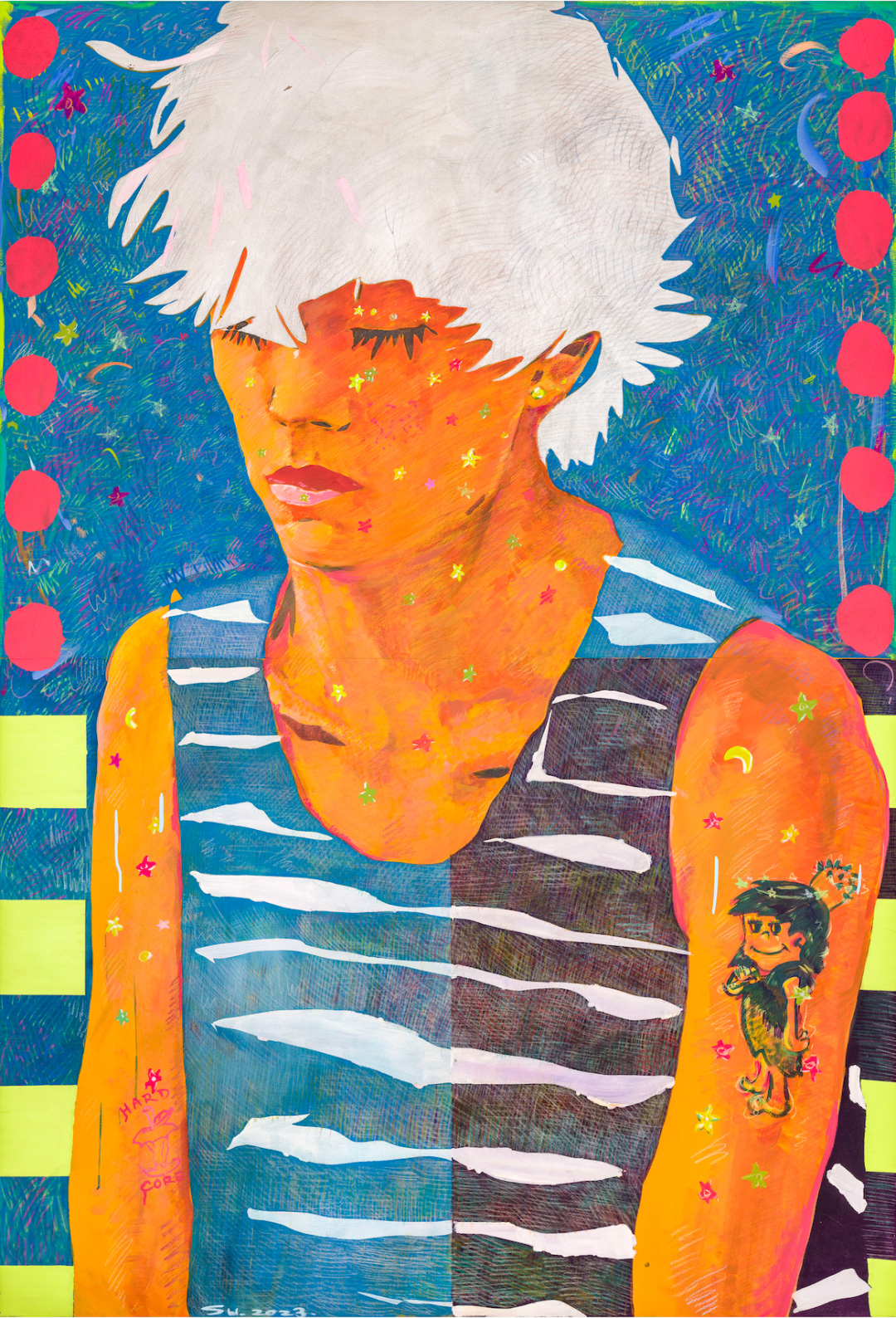
苏昱铭 Su Yuming
舞会后的男孩和失踪的太阳 After Party' s Apollo
麂皮上丙烯,油彩 Acrylic, oil, oil pastels, color pencil on micro suede
190×130cm 2023
苏昱铭(生于1994年)在央美版画系学习正步入第十年,近年在创作中尝试从纸本到布面,从版数到唯一的跨越。他的图像来自于日常生活,有亲友间的自拍与他拍,也有网络图像的截取和拼贴。版画中的分色、叠加、转写等技法被运用于他的绘画中,丙烯与油彩,色块与线条的交织密度是他着迷的,颜料层叠穿插使得画面形成了迷人的凸起与凹陷,跟随笔触观看时能感受到笔尖在画布上行走的沙沙作响。
Su Yuming (born in 1994) is in his tenth year of studying Printmaking at the Central Academy of Fine Arts. In recent years, he has attempted to leap from paper to canvas, and from multiple prints to unique works. His images come from daily life, including selfies and photos taken by friends, as well as screen captures and collages of internet images. The techniques of color separation, superimposition, and transference used in printmaking are applied in his paintings. The intertwining density of acrylic and oil paints, colors and lines are what he is fascinated with. The overlapping layers of paint create fascinating bulges and depressions, and following the brush strokes, one can feel the rustling sound of the nibs walking on the canvas.
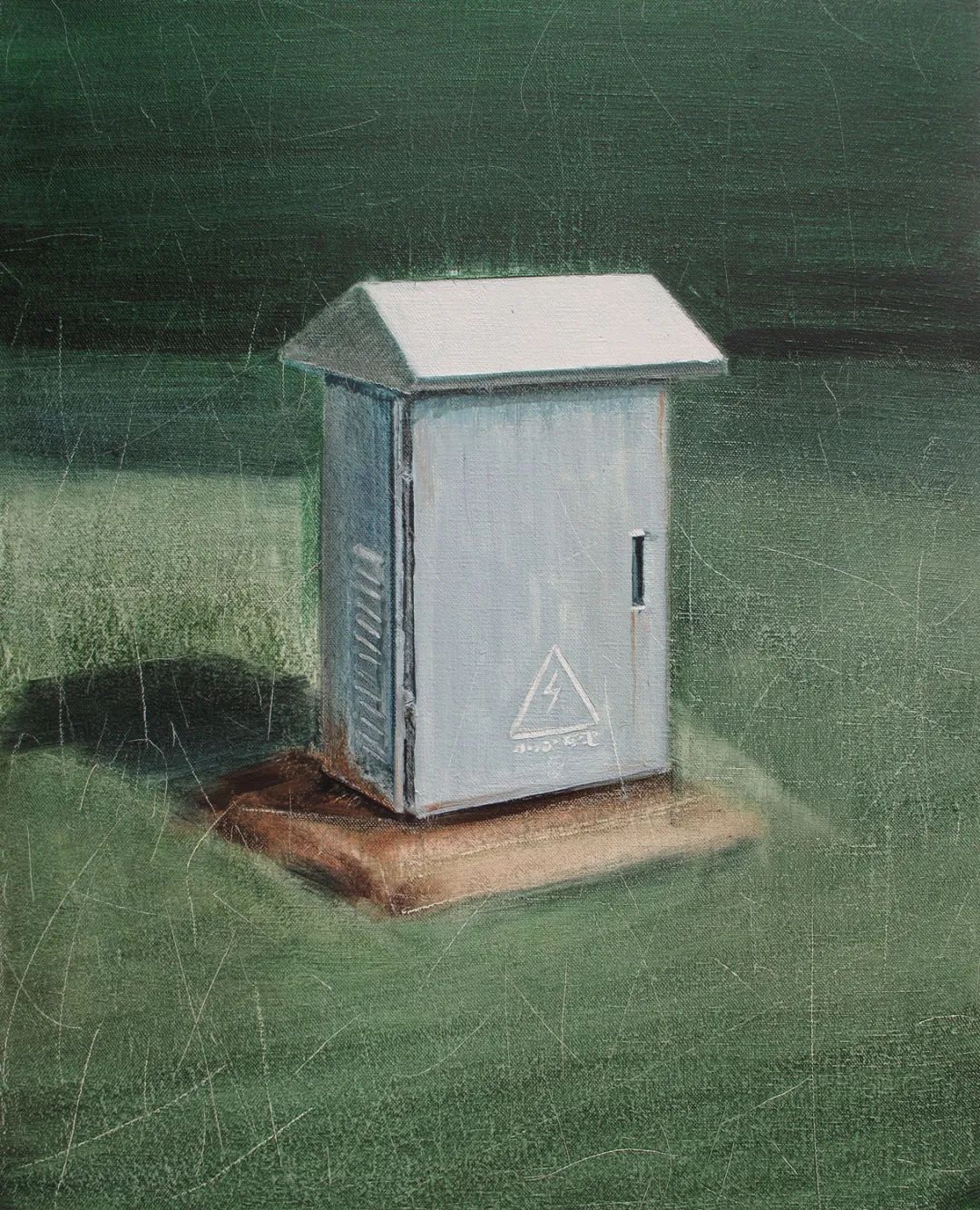
肖喆洛 Xiao Zheluo
既陌生又熟悉的某物—变电箱 Both Strange and Warm Object - Box Substation
布面油彩 Oil on canvas
50×40cm 2010
反观肖喆洛(生于1983)的作品,她在绘画上是“吝啬”的,色彩层极薄,三两笔成型,笔至则形到。她的绘画关注的是“日常”,将生活中的事物作为对象,收敛而控制地描写,这些树、建筑、电箱被赋予人格,而画家则刻意将自己置于缺席的状态,将观者推至画面前[4]。
In contrast, Xiao Zheluo's (born in 1983) paintings are "stingy" in color, with extremely thin layers and formed with just a few brush strokes. Her paintings focus on the "everyday", using objects from daily life as subjects, described in a restrained and controlled manner. These trees, buildings, and box substations are given personalities, while the painter deliberately stays in a state of absence, pushing the viewer to the forefront of the painting[4].

赵亮 Zhao Liang
卧石听松 Hermit's life
亚麻布裱铝板 Mixed material on linen
140×150cm 2023
赵亮(生于1983年)在绘画的色彩饱和度上非常节制,层次则极近繁复。《卧石听松》(2023)在画面上只采用蓝色和白色颜料,大量层叠的松针生机繁茂,盈满画布。人物的缺席给“卧石”和“听松”留足了想象的空白:可能是梁同书(1723年—1815年)在苏州耦园“卧石听涛,满衫松色;开门看雨,一片蕉声”的隐士生活;也或许是陆游(1125年—1210年)戎马归隐后听雪煮茶 “卧石听松风,萧然老桑苎”的宁静满足。
Zhao Liang (born in 1983) exercises great restraint in the color saturation of his paintings, yet his layers are extremely intricate. Hermit's Life (2023) only uses blue and white paint on the canvas, with a large number of overlapping pine needles full of life, filling the entire painting. The absence of figures leaves ample room for imagination in "lying on rocks" and "listening to pines": it could be Liang Tongshu's (1723-1815) hermit life of "lying on rocks and listening to the sound of waves, covered in pine greenness. Opening the door to see rain, hearing the rustling sound of banana leaves." or it could be Lu You's (1125-1210) peaceful satisfaction of listening to the snow fall while brewing tea after his military service retirement, "lying on rocks and listening to the sound of pines, feeling the natural breeze and covered in mulberry leaves."
“画了再画”不仅是绘画行为上的动作重复,更是心态的锤炼。艺术家通过日复一日的绘画训练,将技艺形成肌肉记忆,若再有天赋的加持,自然是有如神助。而如何持久地保持“艺术家”的状态,以及懂得在生活与工作之间切换,则是需要更多时日去调整自我的生物钟。暂停和出神不会阻挠创作,而是形成“灵感”的蓄水池,也是不可或缺的留白和气口。
"A Restless Heart" is not only a repetitive action in painting, but also a tempering of one's mindset. Artists refine their techniques through daily painting exercises, forming muscle memory with their skills. With the addition of natural talent, they are naturally aided by gods. However, maintaining the "artist" state for a long time and knowing how to switch between life and work requires more time to adjust one's biological clock. Pausing and spacing out will not hinder creativity, instead, they form a reservoir of "inspiration," as well as indispensable pauses and breaths.
[1] 作家格拉德威尔在《异类》一书中指出。“人们眼中的天才之所以卓越非凡,并非天资超人一等,而是付出了持续不断的努力。1万小时的锤炼是任何人从平凡变成世界级大师的必要条件。”按比例计算:如果每天工作八个小时,一周工作五天,那么成为一个领域的专家至少需要五年。
[2] 陈熹的第一部动画长片《步行指南》(片长77分)曾入围FIRST 青年电影展的剧情片竞赛单元和惊人首作片单,是FIRST第一次有动画长片入围剧情长片的竞赛。
[3]《王屿星个展—自然码码》,三影堂艺术中心,2023.
[4] “我是一棵树,或者一只椅子。突然,我就出现了,无中生有。没有人追究我从哪儿来,而我随时会消失,在他们不需要我的时候。”《肖喆洛个展“某次缺席”,在缺席中营造物的人格》, 周雪松,雅昌艺术网,2014.
[1] Malcolm Gladwell points out in his book Outliers: The Story of Success that "the reason why people see geniuses as extraordinary is not because they have extraordinary natural abilities, but because they have made continuous and persistent efforts. 10,000 hours of training is the necessary condition for anyone to become a world-class master from the ordinary." By proportion: if you work eight hours a day and work five days a week, it takes at least five years to become an expert in a field.
[2] Chen Xi's first feature-length animation film "Sleepwalking Through The Walk Simulators" (77 minutes) was shortlisted for the Feature Competition Unit of the FIRST IFF and the list of astonishing first works. It was the first time for a feature-length animation film to be shortlisted for the Feature Competition of the FIRST IFF.
[3] Natural Code Code, Three Shadows Photography Art Center, Beijing, 2023
[4] "I am a tree, or a chair. Suddenly, I appeared out of nothing. No one asks where I came from, and I will disappear at any time when they don't need me." "Xiao Zheluo Solo Exhibition "Once Absence", Creating the Personality of Things in Absence", Zhou Xuesong, Artron.Net, 2014.
